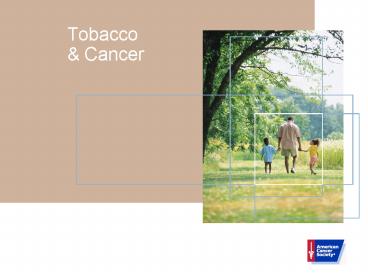Tobacco PowerPoint PPT Presentation
1 / 16
Title: Tobacco
1
Tobacco Cancer
2
Tobacco Use And Cancer
- Tobacco use, the most preventable cause of death
in our society, accounts for at least 30 of all
cancer deaths. - An estimated 45 million adults are current
smokers in the United States. - About half of those who continue to smoke will
die prematurely from smoking. - The best way to avoid getting cancer is to not
start using tobacco or to quit using it.
3
Strength Of Evidence
- Strong evidence over the years has found a clear
cause-and-effect relationship between the use of
tobacco and several types of cancer.
4
Cancers Affected
- Tobacco use is the primary risk factor for lung
cancer.
- Tobacco use is also associated withcancer in
other parts of thebody, including - Cervix
- Mouth
- Pharynx
- Larynx
- Esophagus
- Pancreas
- Kidney
- Bladder
5
Risk Factors
- Smoking
- Nearly 87 of all lung cancers are caused by
smoking. - Smokers are 15 times more likely to die of lung
cancer than people who have never smoked. - Secondhand Smoke
- Each year, secondhand smoke causes
- About 3,000 lung cancer deaths
- 35,000 heart disease deaths
- Respiratory illness and asthma attacks
6
Risk Factors
- Cigars
- Many of the same carcinogens found in cigarettes
are also found in cigars. Cancers caused by cigar
smoking include - Lung
- Oral cavity
- Larynx
- Esophagus
- Pancreas (possibly)
- Snuff
- Oral cancer occurs several times more frequently
among users than non-users. - Long-term snuff users may have nearly a 50-fold
greater risk of cheek and gum cancers.
7
Reducing Your Risk
- Quitting or not using tobacco substantially
decreases the risk of cancer and cardiovascular
disease. - If all adults stopped tobacco use and children
did not start, at least 30 of all cancer deaths
would be prevented. - People who quit, regardless of age, live longer
than people who continue to smoke. - Smokers who quit before the age of 50 cut their
risk of dying in the next 15 years in half.
8
How To Quit Tobacco Use
- The most effective strategies for quitting
tobacco use involve multiple approaches - Behavioral therapy
- Nicotine replacement therapy (gum, skin patches,
inhaler, or spray) - Non-nicotine prescription medication
- Group therapy
- Advice from a doctor or other health care
provider - Combination of therapies
9
Youths And Tobacco Use
- The prevention of tobacco use among children and
youth is equally important, since over 90 of
smokers begin to smoke before age 18. - If children and youth can be prevented from
starting, a substantial portion of
tobacco-related health problems can be solved.
10
Hope For The Future
- Researchers are looking at the role of genetics
in tobacco-related cancers and tobacco
dependence. - Studies are being conducted to determine how
cancer risk can be reducedfor smokers who
cannotstop. - Scientists are studying the potential for
detecting lungcancer at its earliest, and most
curable, stages.
11
Hope For The Future
- Implementing policies that establish smoke-free
environments is the most effective approach to
prevent exposure and harm from secondhand smoke. - Presently in the US, more than 2,650
municipalities have passed smoke-free legislation
and 28 states, the District of Columbia and
Puerto Rico have implemented or enacted statewide
smoking bans.
12
The Bottom Line
- Stopping tobacco use, or not starting, is the
single most important action that can be taken to
reduce cancer in the United States. - If all adults stopped tobacco use and children
did not start - Nearly one-third of all cancer deaths would be
prevented. - Billions of dollars would be saved.
- Millions of family members and friends would
avoid the sickness and premature death of a loved
one.
13
Contact The American Cancer Society
- American Cancer Society programs and services are
available 24 hours a day, 7 days a week. - To reach us
- Visit the American Cancer Society web site at
www.cancer.org. - Call toll-free, 1800ACS2345.
14
Additional Resources
- National Cancer InstituteCancer Information
Service Telephone 18004CANCER (toll
free)Internet www.nci.nih.gov - Alliance for Lung Cancer Advocacy, Support
Education (ALCASE)Telephone 18002982436
(toll free) or 3606991944Internet
www.alcase.org - American Lung AssociationTelephone
18005864872 (toll free) or 2123158700Interne
t www.lungusa.org
15
Additional Resources
- American Heart AssociationTelephone
1800AHA-USA1 (toll free)Internet
www.americanheart.org - Campaign for Tobacco-Free KidsTelephone
2022965469Internet www.tobaccofreekids.org - Center for Tobacco CessationTelephone
1-202-585-3200
16
(No Transcript)

